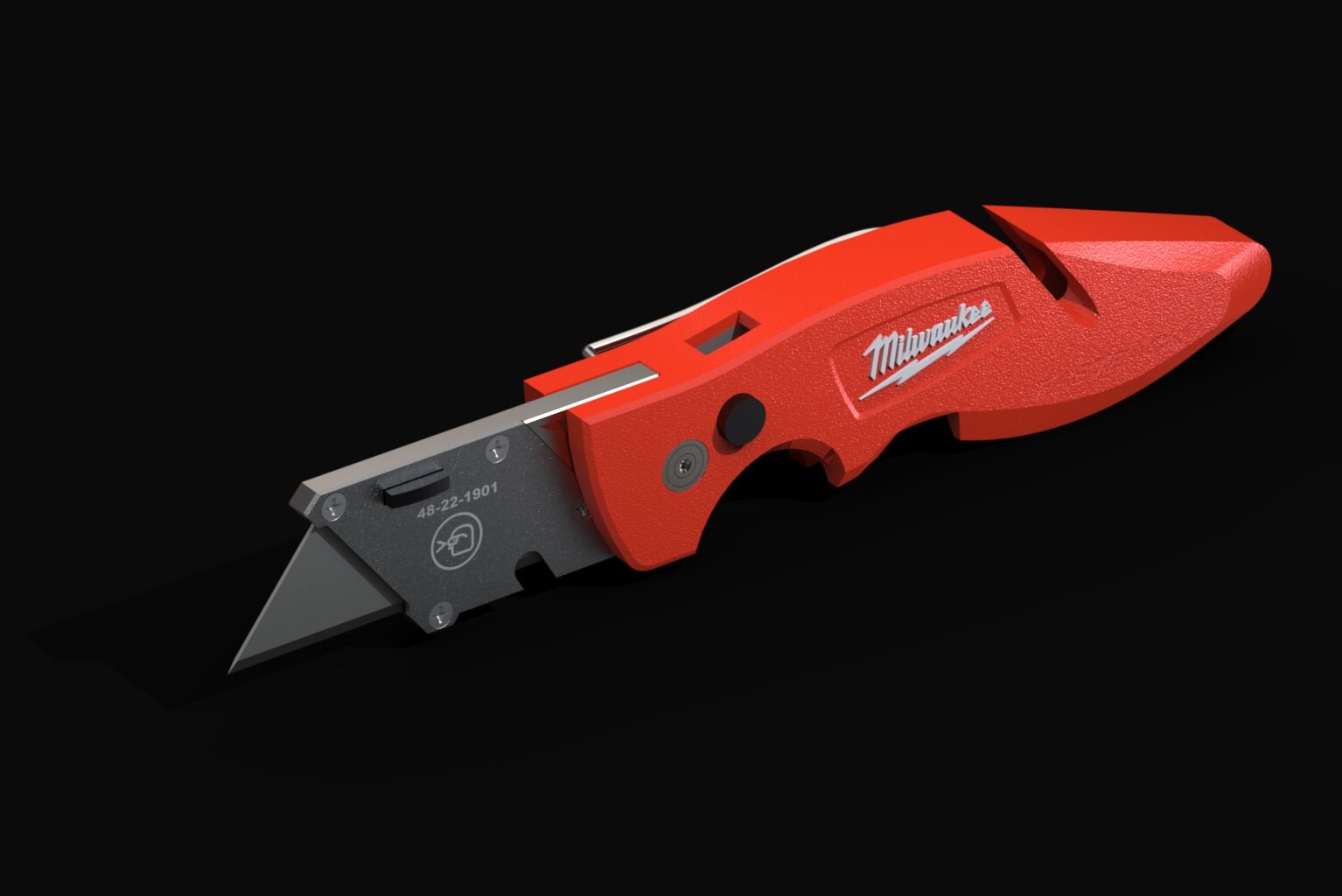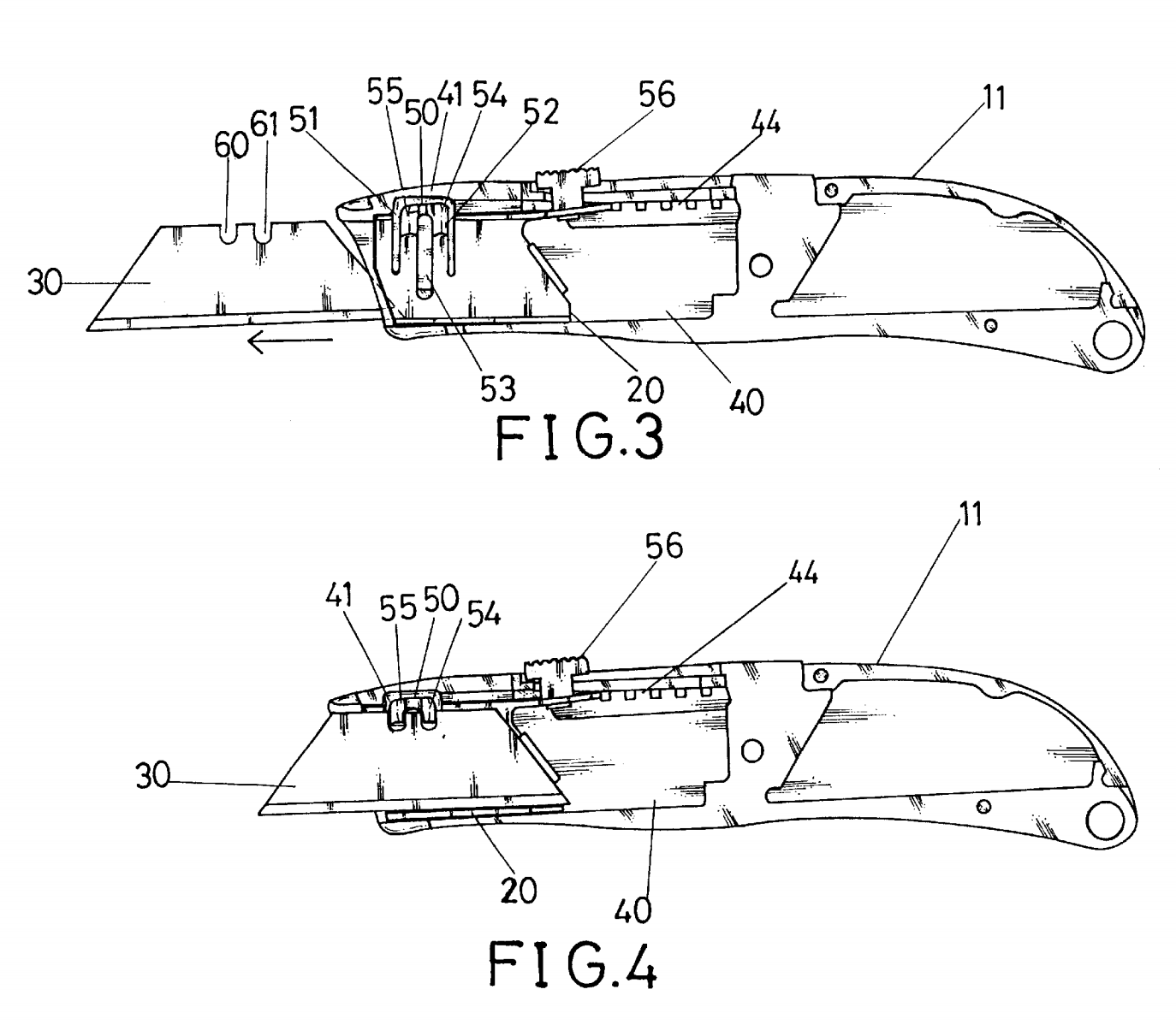Good Design: The Milwaukee Fastback Utility Knife
Editor’s Note: We’re starting a new series on “good design” where we highlight products, systems, and services that embody design principles worth aspiring to. We invite our readers to submit a Good Design article to the BYU Design Review, in hopes that over time we will collect a large number of articles that inspire and instruct us toward better design. This is the first in that series.
Basic Description
In April of 2010, Milwaukee Tool launched a series of hand tools that includes one of my all-time favorites: The Milwaukee Fastback Utility Knife (model 48-22-1901).
Milwaukee Fastback Utility Knife: CAD Model and Rendering by BYU Engineers Nathan Woolley and Noah Smith (2019)
Although the knife has been on the market for 10 years, I bought my first one only 3 years ago after seeing a friend rely on his utility knife way more than I relied on mine, while we worked on a project together. His was a Milwaukee Fastback, and mine was a classic Stanley utility knife (patent image shown below [1]).
What I noticed about my friend’s use of his knife compared to mine centered completely on blade changing – something the Milwaukee Fastback and Stanley knives do entirely differently. To change the blade on the Milwaukee, simply press the rectangular button (see Design Patent image below [2]) and pull the blade out, then slide in a new one. To change the blade on the Stanley, remove the large screw that holds the left and right housings together and separate the two halves of the knife, take the blade out of the slider mechanism, place a new blade in, realign the slider mechanism, reassemble the two housing halves, place and tighten the screw, and test the final assembly to see that the mechanism slides properly.
Unknown to me at the time, the Stanley approach to blade changing negatively affected my experience and the quality of my work. Let me explain; I distinctly remember multiple times using a Stanley-style utility knife with a dull blade, thinking to myself I don’t want to stop and change the blade, I can just keep going. Inevitably the tool never worked as well as it should have and my work never turned out as clean as I had hoped. Now, using only my Milwaukee utility knife -- which promotes simple tool free blade changes -- I can truly say that I don’t ever recall using it with a dull blade.
Underlying Design Principle
From a design perspective, the underlying principle behind Milwaukee’s success is user-centered design. User-centered design involves basing design work on an explicit understanding of users, their tasks, and the environment in which they carry out those tasks. Importantly, user-centered design requires a deep understanding of actual (not assumed) user needs and behavior. Had a Stanley engineer been in my head when I said I don’t want to stop and change the blade, I can just keep going, a deeper understanding of me, my task, and the environment I was working in would have been gained – clearly leading to opportunities for innovation. Good designers find a way to get inside the heads of users, and truly understand what they’re thinking.
Sometime in the last three years, as I transitioned from my trusty Stanley to the well-designed Milwaukee, I learned something obvious. The sharpness of the blade is the single greatest factor in user experience with a utility knife. The most ergonomic knife with a dull blade will produce a bad user experience. The lightest knife with a dull blade will produce a bad user experience. And so on…
The interesting part here is that modern utility knives all take the same blade, so what determines user experience is how easily, reliably, safely, and quickly the blade on a utility knife can be changed. The Milwaukee approach is second to none, and for this reason the Fastback is one of my favorite tools.
Milwaukee’s attention to the user experience shows up in other notable ways that are an indication that this product is the result of excellent user-centered design. (1) The folding tool can be opened and closed with one hand very quickly, pressing just one button and flicking the wrist. It is incredibly effective and useful, especially when holding something to be cut in your other hand. Mikwaukee user-studies show that it can be opened three times faster than competitors. (2) The huge index finger and subtle thumb rest area are also a major improvement over my Stanley (see patent image above). With the Mikwaukee, my hand has a specific place where it is sure to stay when applying a lot of cutting force. And the thumb area is very effective at allowing me to control the blade more accurately than I could control my Stanley. (3) The wire-formed belt clip is also a user-centered design innovation that I like (see image below). Because this clip is wire formed, and not stamped as all other clips are, it has no sharp edges and no pointed parts, which leads to less fraying and damage to clothing or other objects you’d attach the knife to. (4) The integrated gut hook, is also useful for cutting string, wire, or pallet binding without opening the knife.
Some Additional History
Although the Milwaukee Fastback is incredibly popular and tops many utility knife review lists, it would be unfair to attribute all of the Fastback’s features to Milwaukee tool. Three important innovations preceded the Fastback: For decades, utility knives did not have retractable blades, which of course caused problems retrieving them from tool boxes, patents in 1960 [3] and 1963 [2] led to the concept of safe storage. Later in 2010, Irwin Tool improved stowability by introducing a folding utility knife [4]. But the patent most related to the quick changing of blades was issued in 2001 to Taiwanese inventor Hsing Tai Lin, as shown below [5]. Button 301 is pressed and the blade (30) moves in the direction of 5. This of course is a huge improvement over removing the screw (35) to load a new blade.
So what did Milwaukee do so well? They make the entire knife development process about the user experience. They pulled from existing technology and created some of their own. What resulted is a great knife that increases productivity and quality of work.
References:
[1] Robinson, W.H., “Utility Knife”, 1963, United States Design Patent, US 3,107,426.
[2] Bublitz, S., Crowe, J., Burch, W., and Holly, J., “Utility Knife”, 2013, United States Design Patent, US D686,901 S.
[3] Ortner, S., “Push Button Knife”, 1960, United States Patent, US 2,948,961.
[4] LeBlanc, N., Levine, S.R., Leyden, C.S., “Folding Utility Knife”, 2010, United States Patent, US 7,814,664 B2.
[5] Lin, H.T., “Blade Support Device for a Knife”, 2001, United States Patent, US 6,249,975 B1.
To cite this article:
Mattson, Chris. “Good Design: The Milwaukee Fastback Utility Knife.” The BYU Design Review, 13 May 2020, https://www.designreview.byu.edu/collections/good-design-the-milwaukee-fastback-utility-knife.











